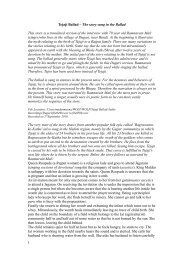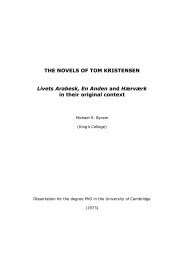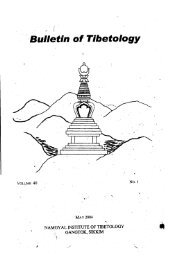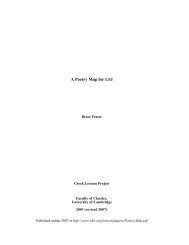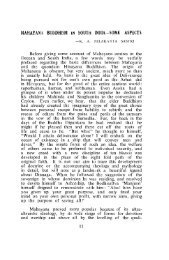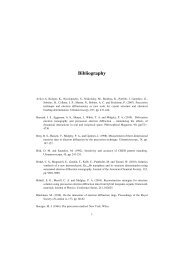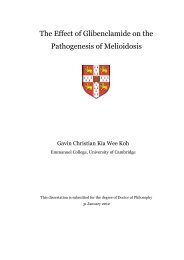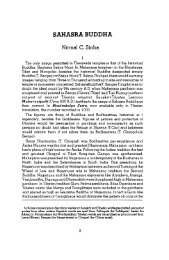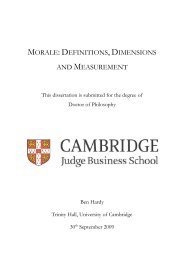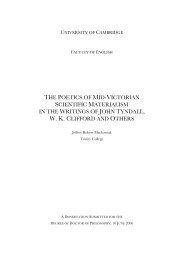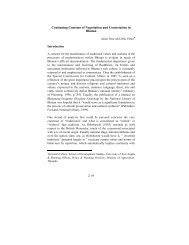The Crusades, the Genoese and the Latin East - DSpace at ...
The Crusades, the Genoese and the Latin East - DSpace at ...
The Crusades, the Genoese and the Latin East - DSpace at ...
Create successful ePaper yourself
Turn your PDF publications into a flip-book with our unique Google optimized e-Paper software.
such specific<strong>at</strong>ion was necessary. It was a result in a change in <strong>the</strong> notaries' style or formulae th<strong>at</strong><br />
<strong>the</strong>y employed. More inform<strong>at</strong>ion about Genoa's ships, however, is available in <strong>the</strong> <strong>Genoese</strong><br />
annals. On special occasions when ships are mentioned, <strong>the</strong> names were often specified as well as<br />
o<strong>the</strong>r details about <strong>the</strong> ships, for example, in <strong>the</strong> descriptions of maritime confront<strong>at</strong>ion, when <strong>the</strong><br />
enemy's ships were seized or when <strong>Genoese</strong> ships were taken or shipwrecked in storms. 352 <strong>The</strong><br />
annals mention <strong>the</strong> Palmeta <strong>and</strong> Rosa, two Pisan ships th<strong>at</strong> <strong>the</strong> <strong>Genoese</strong> captured in 1203. <strong>The</strong><br />
Leopardus was ano<strong>the</strong>r Pisan ship seized by <strong>the</strong> famous <strong>Genoese</strong> pir<strong>at</strong>e,<br />
Count Alamanno de<br />
Costa, in 1204. L<strong>at</strong>er <strong>the</strong> same ship is mentioned as <strong>the</strong> ship of Count Henry of Malta. In 1213, a<br />
new ship, Stella, entered <strong>the</strong> annals because it was accidentally set on fire when it was being<br />
caulked.<br />
<strong>The</strong> inclusion of names of ships in <strong>the</strong> notarial documents is very valuable. By utilising<br />
this inform<strong>at</strong>ion one may follow, for <strong>the</strong> first time, <strong>the</strong> travel history of <strong>the</strong> ships in addition to <strong>the</strong><br />
history of merchants or families of merchants. A rel<strong>at</strong>ively large number of vessels sailed to <strong>the</strong><br />
<strong>L<strong>at</strong>in</strong> <strong>East</strong> in 1216. Six ships is a large number compared to <strong>the</strong> two th<strong>at</strong> are known to have sailed<br />
<strong>the</strong>re in 1198 (while four sailed to Alex<strong>and</strong>ria), two or three in 1200,353 four in 1203 two in<br />
'314<br />
1213,355<br />
<strong>and</strong> so on. Significantly, one of <strong>the</strong> six ships th<strong>at</strong> sailed to <strong>the</strong> <strong>L<strong>at</strong>in</strong> <strong>East</strong> was <strong>the</strong> Ia/na de<br />
Finar. In previous years this ship often sailed to Alex<strong>and</strong>ria.<br />
Table 1: <strong>Genoese</strong> ships <strong>and</strong> <strong>the</strong>ir destin<strong>at</strong>ions<br />
1198 1200-1 1203 1213 1214 1216 1222 1226<br />
Genoa - 2 2 or 3 4 2 3 6<br />
Ultramare<br />
Genoa<br />
- 4 1 or 2 1 3<br />
Alex<strong>and</strong>ria<br />
- - - -<br />
Why did so many ships sail to <strong>the</strong> <strong>L<strong>at</strong>in</strong> <strong>East</strong> in 1216? One of <strong>the</strong> ships, <strong>the</strong> St Peter,<br />
carried arms to Acre. Bonaventura scutarius, a shield maker, as his name suggests, borrowed £4<br />
as a sea-loan, which he promised to pay back in Acre in local currency, 12 bezants. As a security<br />
(pignus) Bonaventura gave to <strong>the</strong> o<strong>the</strong>r merchant 40 shields (scuti) <strong>and</strong> 9 helmets (elmos). Did<br />
Bonaventura travel to <strong>the</strong> <strong>L<strong>at</strong>in</strong> <strong>East</strong> just in order to sell his products, or did he plan to stay <strong>the</strong>re<br />
for awhile? 356 Ano<strong>the</strong>r merchant named Don<strong>at</strong>us de Castello calaf<strong>at</strong>us (caulker) signed a<br />
352 See also Krueger, Navi e proprietä navale a Genova seconda meta del sec. XII, p. 57f<br />
353 <strong>The</strong> St Petri de Arena is mentioned in OS, 1200, cart. 4, p. 258V6 <strong>and</strong> possibly ano<strong>the</strong>r ship th<strong>at</strong> is<br />
mentioned in <strong>the</strong> same page, R2; <strong>the</strong> Buixnigra or Buianigue is mentioned by Gugliemo di Son, MS 102, p.<br />
162V4 <strong>and</strong> p. 164V2.<br />
354<br />
<strong>The</strong> Luna returned from Ultramare, GG, no. 538; <strong>The</strong> Donna, Dedonna <strong>and</strong> Navara sailed to <strong>the</strong> <strong>L<strong>at</strong>in</strong><br />
<strong>East</strong> see GG, nos. 572,586,783.<br />
355<br />
., _<br />
i ne 31 Luchas <strong>and</strong> Melior<strong>at</strong>a, OS, 1213, Cart. 4, a-<br />
p. 198R2, <strong>and</strong> 198V4.<br />
Lanfranco, 1216, no. 1130, from 23 September 1216<br />
102



